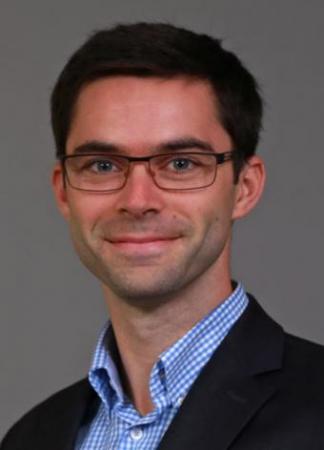
Assistant Professor of Engineering
Credit: Amy Simmons/Brown University
Understanding the neurological basis of movement could lead to implantable sensors that can relay the brain's instructions to nerves and muscles across damaged spinal cords. David Borton is working toward such implantable "bridge" devices.
The capacity of the human body to make incredibly precise and powerful movements was on full display last summer during the World Cup soccer tournament. David Borton, new assistant professor of engineering, knows all about the moves needed to be a successful soccer player. For two years in his late teens, he played professionally for Santos FC in Brazil — a squad whose all-time leading scorer is the great Pelé. But after coming to the realization that there was more to his life than soccer, Borton decided to go back to school to become an engineer.
Now, in his neuroengineering lab at Brown, Borton is developing technologies to better understand the neurological underpinnings of human movement. Ultimately, he hopes to help develop neural prosthetic systems to restore movement for those who have lost it to injury or disease.
In part, Borton says, it is his experience playing soccer that motivates his work to help people with motor difficulties.
"It touches a little bit closer to home when you see people who are paralyzed and they can't do the kind of things that made such a big impact in your own life," he said. "You want to help restore that for them, and help them get back to interacting with the world fully again."
The appointment to the Brown faculty is a homecoming for Borton. He earned his Ph.D. here, working with Arto Nurmikko in the School of Engineering. In Nurmikko's lab, Borton helped to develop the first fully implantable wireless brain sensor. The device, which has operated successfully in the brains of animal research subjects, records and transmits neural signals generated as the animals move. A better understanding of those neural signals will aid in making new brain-computer interfaces that can restore people's ability to move.
The key advance of this device is that it's wireless. It enables researchers to collect brain signals in high fidelity while animals are moving around freely.
"All of the current understanding of how our brain controls movement is learned from animal studies in constrained conditions," Borton said. "That's because we didn't have the wireless technology available to us to have these animals freely moving in their natural environment. Getting data from natural movement is a big thing. It gets rid of some of the traditional restraints on neuroscience research."
Borton plans to continue to develop technologies that push the boundaries in neuroscience and decode the mysteries of movement. "The focus of our lab," he said, "is building technologies that can answer old questions in neuroscience and help ask new ones."
Borton already has lined up collaborations toward those ends.
He plans to work with Gabriel Taubin, professor of computer science and engineering, who is an expert in computer vision. With Taubin, Borton would like to develop new ways of using computer imaging to monitor and quantify the movements of animals in the lab. Borton will also work with Jacob Rosenstein in the School of Engineering to develop kinematic sensors that can be implanted directly into joints as another means of capturing fine detail in movement. Those detailed movement data can then be combined with data from brain sensors to shed new light on the neural basis of movement.
But the ultimate goal of restoring movement for people who have had a neural insult will require more than collecting neural data on movement. Borton would like to find new ways of reinstalling that information back into the nervous system. During a postdoctoral appointment at Ecole Polytechnique Fédérale de Lausanne (EPFL) in Switzerland, Borton worked on new techniques to do just that.
"During my postdoc, I worked on systems — not just devices, but systems of devices — that can talk to each other and find ways to read from one part of the nervous system and write into another part," Borton said. "That means understanding the information coming from the brain and building a useful signal to bring it back into the nervous system."
The effect is a cortico-spinal bridge that reconnects regions of the nervous system that have been separated by injury or disease. And while he's building those technological bridges, Borton would also like to build a research bridge across the Atlantic to EPFL.
John Donoghue, director of the Brown Institute for Brain Science, is on leave this year to help set up a new neuroengineering center at EPFL. As Borton settles in here at Brown, he envisions a steady stream of researchers and students moving back and forth between the two institutions.
"I want to help students from both EPFL and Brown to have the experience that I had in seeing a whole different set of labs," Borton said. "EPFL is one of the top universities in Europe, so it's great to have that connection."
Borton says he's pleased to have the opportunity to return to Brown, and he looks forward to reconnecting with the faculty members who helped guide him through his Ph.D. work — this time as a colleague rather than a student.
"The good thing about Brown is even when you are a grad student most professors treat you as a colleague anyway," he said. "That's one of the more powerful attributes of the Brown community."
- by Kevin Stacey